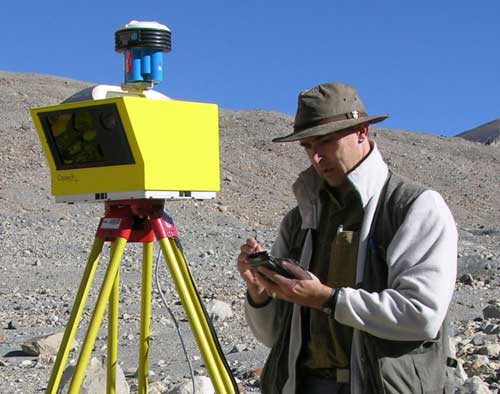Already recognized as a national leader in remote sensing technology and its applications, the University of Lethbridge has added to its research capacity with the addition of a new Chair in Terrestrial Ecosystem Remote Sensing, Dr. Chris Hopkinson.

Hopkinson is the second of four new research Chairs being added to the University this year as part of the Government of Alberta's Campus Alberta Innovation Program (CAIP) Chairs plan. The government is contributing $1-million per year over the course of seven years, for a total investment of $7 million.
"The opportunity to bring an international talent such as Dr. Hopkinson to the University is outstanding," says Dr. Dan Weeks, the University's vice-president (research). "A dedicated researcher and teacher with advanced capabilities in geomatics, water and forest resources, his expertise is an excellent complement to the work already being done on campus by the Alberta Terrestrial Imaging Centre (ATIC)."
Hopkinson comes to the University after spending the last year as an environmental research scientist at the Commonwealth Scientific and Industrial Research Organisation in Canberra, Aus. His research program with the Australian Government is aimed at integrating ground-based, airborne and satellite LiDAR (remote sensing) data to estimate changes in forest biomass carbon stocks. He looks to expand ATIC's capacity in lidar research to address needs within Alberta's sustainable resources and environment department, while supporting the development of national industry standards.
"I first came to Canada as a graduate student with the specific intent to apply field and remote sensing methods to the study of glacial water resources in the Canadian Rockies. During this time, Alberta became my second home and I looked forward to my many field trips to the mountains and icefields," says Hopkinson. "After living and working in several locations since then, it almost feels like coming home to be back in Alberta; now able to set down roots in Lethbridge. It is, indeed, an honour to have the opportunity to work closely with prestigious colleagues and friends at the University of Lethbridge. As part of this team, I hope to assist in maintaining and growing the high profile of remote sensing research for which the Alberta Terrestrial Imaging Centre is known."
Prior to his work in Australia, Hopkinson was a research scientist with the Applied Geomatics Research Group, while also supervising graduate students and serving as an adjunct professor at Acadia University, Dalhousie University and Wilfrid Laurier University. From 2002 to present, Hopkinson has been involved with 40 successful projects that have received more than $8 million in government or industrial funding. He earned his bachelor's degree in geography from Manchester University in Manchester, UK, and both his master's and PhD from Wilfrid Laurier University in Waterloo, Ont.
The CAIP Chairs plan is part of the Government of Alberta's Campus Alberta collaborative initiative and provides an initial 16 research Chairs to Alberta's four Comprehensive Academic and Research Intensive (CARI) institutions: the University of Lethbridge, Athabasca University, the University of Alberta and the University of Calgary.
The U of L introduced Dr. Greg Pyle as its Chair in Aquatic Health earlier this year, and will also welcome CAIP Chairs in the areas of brain health and dementia, and synthetic biology later this year. Hopkinson's appointment at the U of L is funded for seven years.
"The program is designed to recruit new research leaders to Alberta in specific areas of study," says Weeks. "Not only do these areas align with the Government of Alberta's strategic priorities, but they also reflect the core strengths of our institution."
